This Arctic Blast Escalated Quickly
Thus far in November, a few arctic fronts have made their way across the Continental U.S., which have resulted in some unusually cold lows across the Northern Rockies and Upper Midwest. But this latest front is quite the doozy when it comes to cold blasts. Case in point, at the University of Georgia, our temperature swing is expected to be 44 degrees in 24 hours (69 to 25F). That forecasted low of 25F is just a couple of degrees off of our record low for the date. And to think that on October 2, 2019, our high was 101F… we have some very confused plants currently. Chances are, you are in a similar situation—and I don't want to hear any bragging from southern California or south Florida folks!
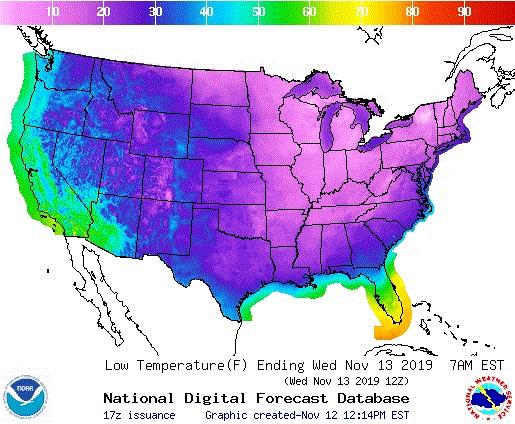
Forecasted low temps across the Continental U.S. for the night of November 12, 2019. Blue means it's going to be chilly.
So the question I have been asked (literally) every 15 minutes today is, “Can plants be protected from sudden and extreme cold temperatures?” The short answer is—it depends. Let’s walk through a few scenarios based more on my experience than scientific studies—focusing on woody plants.

The Plight of Softwood Growth
Freeze damage to woody plants in the fall is just like plant damage in the spring, in that the newest growth (also termed softwood growth or butterwood) will receive the most substantial damage. Also, broadleaf evergreens seem to bear the brunt of damage compared to conifers or deciduous trees and shrubs. Most of this new softwood growth occurs in early-mid fall (September until the freeze date) and is the result of improved environmental conditions in the fall (lower temperatures and more soil moisture). This “fall flush” of growth is encouraged by high fertility levels and abundant soil moisture and for these reasons, generally it is not recommended that fertilizer be applied in the last third of the growing season, unless you are trying to correct a nutrient deficiency. It’s also recommended to taper off irrigation, especially to established shrubs and trees, during fall.
Getting back to softwood growth … it will be damaged when temps drop below 32F, but things get progressively worse down to 25F. At this point, new growth will die back completely to the point where the fall growth was initiated. Symptoms are similar to spring freeze damage in that stems and foliage will wilt and turn a dark brown/black to purple color. The only real remedy for this is to tip prune damaged stems or wait for spring bud break, which will cover damaged growth with time.
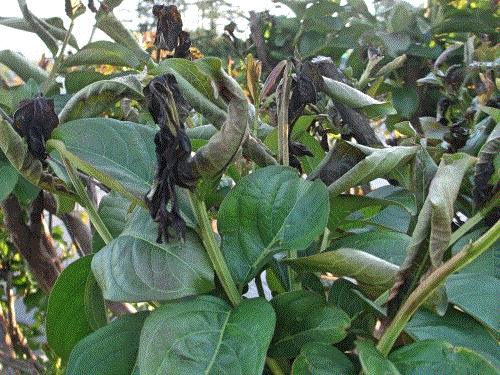
Typical damage to softwood growth includes black and wilted stems (particularly stem tips), as seen here. Photo courtesy of Dr. Amy Fulcher, University of Tennessee.
So—can you protect plants with softwood growth by covering or using irrigation? In cases where plants can be covered, that only gets you a few degrees of protection. So if you are dropping below 27-28F, it is unlikely to help. Same for irrigating. Sometimes we just have to suck it up.

The Plight of Containerized Woodies
There is an age-old misconception about woodies grown in containers—being that they are just as protected (from extreme cold) as plants in landscapes. Well, I say not so fast. In addition to what I mentioned above, container plants have a couple of significant disadvantages because the root system is above ground, and therefore is subjected to ambient air temps (unless covered in snow). Remember that a plant’s hardiness zone rating was developed based upon observing plants grown in-ground, not in a container (more on that in a bit).
Let’s look at a familiar scenario that plays out across the central and Northeastern U.S. annually, using Japanese maples as an example, as they are fairly cold hardy as a whole, listed as Zone 5b cold hardy (-10 to -15F). Let’s say you’re located in Cincinnati, Ohio (Zone 6b), so you assume that your (or your clients’) containerized Japanese maples will be fine with an early arctic blast that results in temps only dropping to 14F. After all, that is far above that Zone 5b minimum temperature of -10 to -15F. But after that initial 14F night, stems turn brittle and dark gray and you realize that the prized Japanese maple is doomed. How could that be?
Well, there are two factors at play. First, plants must undergo an acclimation period to cold weather, whereby they gradually become more cold-hardy as late fall and early winter progress due to reduced daylength and cooler nighttime temperatures. Only during mid-winter (mid-December to early March) are plants most acclimated to extreme cold weather. This is why extreme cold snaps in early fall lead to more plant damage. Second is an old rule of thumb that was passed to me by the late Fred Gallee (Callaway Gardens), yet one that seems to hold true. A containerized plant is typically subjected to temperatures indicative of two cold hardiness zones north (colder) of where they are located. So, essentially if you are in Zone 6b (Cincinnati, Ohio), that container plant experiences minimum root-temperatures equivalent to Zone 4b in an average year. Suddenly, that Zone 5b hardy Japanese maple is not so cold hardy in that container.

The Plight of Broadleaf Evergreens
While not necessarily seen in early freeze events, I figured I would mention one other issue commonly observed in broadleaf evergreen woody ornamentals. Have you ever noticed that not a lot of broadleaf evergreen taxa are grown in Zones 3-6a? There is a reason why the majority of broadleaf evergreen trees and shrubs are not cold hardy north of Zone 6b (many not north of Zone 7a). And ironically, it has a lot to do with drought damage rather than cold damage, even though prolonged below-freezing periods are the ultimate cause.
Broadleaf evergreens are just that—evergreen. As a result, they continue to photosynthesize all year, and photosynthesis requires those stomata to be open. When stomata are open, carbon dioxide enters the stomata and oxygen and water are released. The important point is that water is released. Now you may think to yourself, how could a leaf photosynthesize when temps are below freezing, but in all actuality on a sunny day with temperatures at or just below freezing, the sun warms foliage (particularly the outermost leaves that receive a lot of sun) to well above freezing.
The problem is that stems on the interior (shaded) areas of the plant that generally provide those photosynthesizing leaves with water are sometimes still frozen—as is often the ground itself. So while water is being transpired, foliage is not receiving any water to replenish what is lost. As a result, the photosynthesizing foliage succumbs not to cold stress, but rather to drought stress. In this case, symptoms look just like mid-summer drought stress. Foliage becomes chlorotic and then necrotic (browns) and then drops. This exposes the next (interior) set of leaves to the sun which go through the same process until those leaves drop. Sooner or later, all foliage drops and the plant dies.
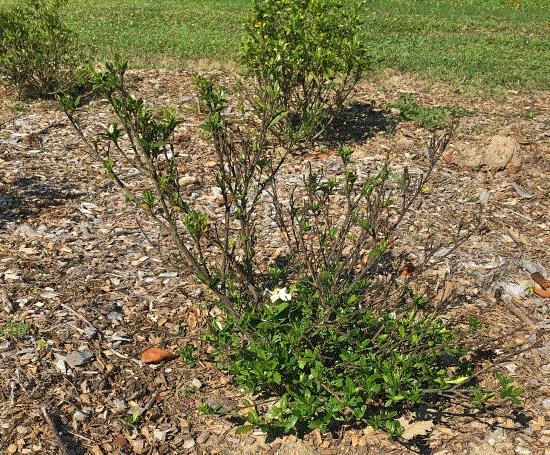
Pictured here is a gardenia after an especially brutal winter in Virginia. Note how the majority of remaining foliage is at the base of the plant, while little foliage remains on the upper stems.
That concludes your cold physiology lesson for today … you will receive a test in the form of a nightmare. My apologies.

Aralia Sun King—PPA Plant of the Year
The Perennial Plant Association announced on October 1st that Aralia ‘Sun King’ has been awarded the 2020 Perennial Plant of the Year. Aralia 'Sun King' brings a bright pop of glowing color and texture—the perfect anchor for the shade to part shade border.
What’s even more exciting is that with no patents or other restrictions, Aralia ‘Sun King’ is open to all growers. The plant has bold, golden yellow to chartreuse compound foliage that is deer-tolerant (meaning deer will wait until they are really hungry to eat it). Bigger than your average perennial, Sun King is typically 4 ft. tall and wide, once established, but 6 ft. tall is not unusual for older plants. Aralia ‘Sun King’ won the International Hardy Plant Union Outstanding Plant Award in 2012. The species Aralia cordata is a member of the Araliaceae family. Native to Japan, Korea, and Southeast China, where the young shoots are harvested and and then blanched or pickled.
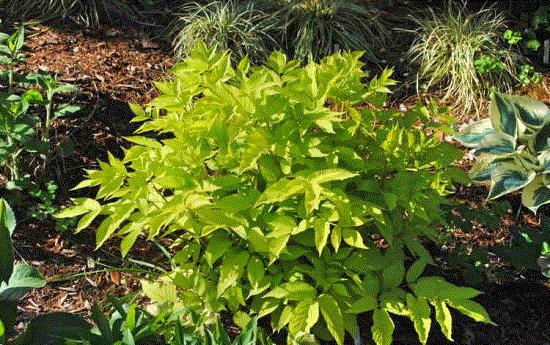
Photo courtesy of the J.C. Raulston Arboretum.
This perennial has become a beloved shade garden staple across the U.S. Bright yellow shoots emerge in spring, then grow up, up, up ... to quickly form a large shrub-like clump that is an outstanding accent plant. The small, cream-colored umbels of flowers arrive in clusters in the summer and are attractive to bees and other pollinators. Fall brings tiny dark berries adored by birds (but inedible to humans). Despite Sun King’s stature, it's very well-behaved—little to no reseeding or suckering. With a hardiness in USDA zones 3 to 9, this perennial is not picky with soil, liking moisture but with good drainage. If you are looking for an excellent perennial for your next landscape project or something reliable for your gardens, make sure to check out this winner!

USDA Releases Interim Hemp Production Rules
While not something I normally cover in Nursery & Landscape Insider, there has been enough interest from growers that I wanted to pass along an update I received last week from Chris Butts (GA Green Industry Association, Executive Director). The short version is that finally, USDA has released the "interim final rule" regarding hemp production after multiple delays (since passing the last Farm Bill).
That’s where things get a bit sticky, as many states have developed regulations (generally enforced by a state’s Department of Agriculture) that contradict federal regulations. For example, according to federal rules, "USDA recognizes that hemp producers may take the necessary steps and precautions to produce hemp ... yet still produce plants that exceed the acceptable hemp THC level". As a result, testing protocols will include a margin of error that will allow THC levels as high as 0.05% without the grower being considered in negligent violation of the 0.03% maximum THC levels that remain unchanged in the rules. The rules also prohibit states from restricting interstate shipping of hemp products. This is in direct contrast to several states which prohibit THC levels above 0.03% and prohibit interstate commerce.
Ultimately, individual states will most likely need to adjust rules to comply with USDA guidelines, but negotiations will also be a part of the process. For now, an excellent introduction to the USDA Program can be seen here.

Live Oak
It’s time for the biannual appearance from my astute and spunky graduate student, Mary Lewis (she loves writing about plants). Without delay, I turn it over to her to share a different perspective on a cool plant. When reading this, imagine an overly caffeinated graduate student and you will be spot-on.
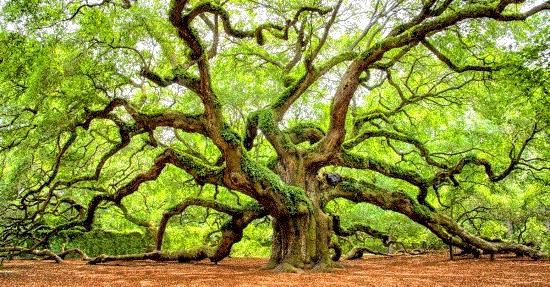
The Angel Oak. Photo courtesy of Mary Lewis.
Taking a break from scientific writing and therefore writing the way normal people do is uncommon for graduate students who are locked in a greenhouse and/or laboratory, so excuse my excitement. Being a Charleston (South Carolina) lady and therefore sticking to my roots, I would like to present a hometown favorite…. Quercus virginiana! Or in my area of the world ... Southern Live oak. A nearly evergreen oak (drops leaves intermittently, but never all at once) that typically hosts Spanish moss, this was my favorite climbing tree as a child.
Sadly, it has a very narrow growing range, from about zones 7-9b in the coastal plain. Once established, it can reach 50-80 ft. tall, and has all the branching a child could ever want. Honestly, I've never seen a specimen top 65 feet because their crowns are so wide and give rise to prolific branching.
One very specific specimen is the Angel Oak, a tree I grew up admiring at Angel Oak Park on Johns Island, South Carolina. It’s touted as the oldest broadleaf tree east of the Mississippi, and one of the oldest trees in the U.S. At few years over 400, this long-limbed rascal actually owns itself. Having its own address and preserved land, this tree is open to the public for viewing and visiting. As a wee child, I will own to having clambered all over this tree, and given that my father was a forester, I’m shocked and horrified he let me do that to such an ancient specimen.
There is something almost magical about walking around the base of it and seeing how some of the branches touch the ground and then meander upwards again so the toddlers can also learn to climb. If you ever find yourself near Charleston, South Carolina/John’s Island region ... go check this living legend out. Just think ... it’s older than the United States!

Our Wacky Wonderful World—Notes from the Edge of Sanity
As a college professor, rarely does a day pass when I am not bombarded with political and/or social divisiveness, which seemingly has become more and more polarizing as my adulthood has passed. Quite honestly, it’s exhausting to simply turn on the news these days. Every topic seemingly requires us to choose a side or to stake a claim to an ideology that often we know little about. But this isn’t a political rant as much as it is a philosophical notice.
Did you know that there is a new movie coming out called "A Beautiful Day in the Neighborhood" that chronicles how one man was able to guide several generations of youth towards a life of acceptance and tolerance? Yep—a movie that depicts the life and work of Fred Rogers (a.k.a. Mr. Rogers). A man who served the world from 1968 until 2001, without fail, generating a message of hope and peace. At times ridiculed or the butt of jokes, he never lost his passion for being compassionate. A man who read to so many of us when our parents did not have time to read because they were working two and three jobs. A guy who taught us how to tie our shoes because we were too embarrassed to ask anyone else. A guy to taught us how to blow a huge bubble-gum bubble. Never did he judge others, rather he taught kids to accept others.
I sure miss ol' Fred Rogers and I hope we can all remember his message of having patience, being reflective and valuing silence in this noisy world. Most importantly, remember that we’re all neighbors, and we all deserve a little compassion, even when we need reminding to be accepting of one another.

Live authentic,

Matthew Chappell
Editor-at-Large
Nursery & Landscape Insider
This has been received by 27,013 of the hardest-working horticulturists in show business!
If you're interested in reaching 27,013 (and growing) clients who eagerly await every Nursery & Landscape Insider and surely read every word, contact Kim Brown ASAP and she'll hook you up.